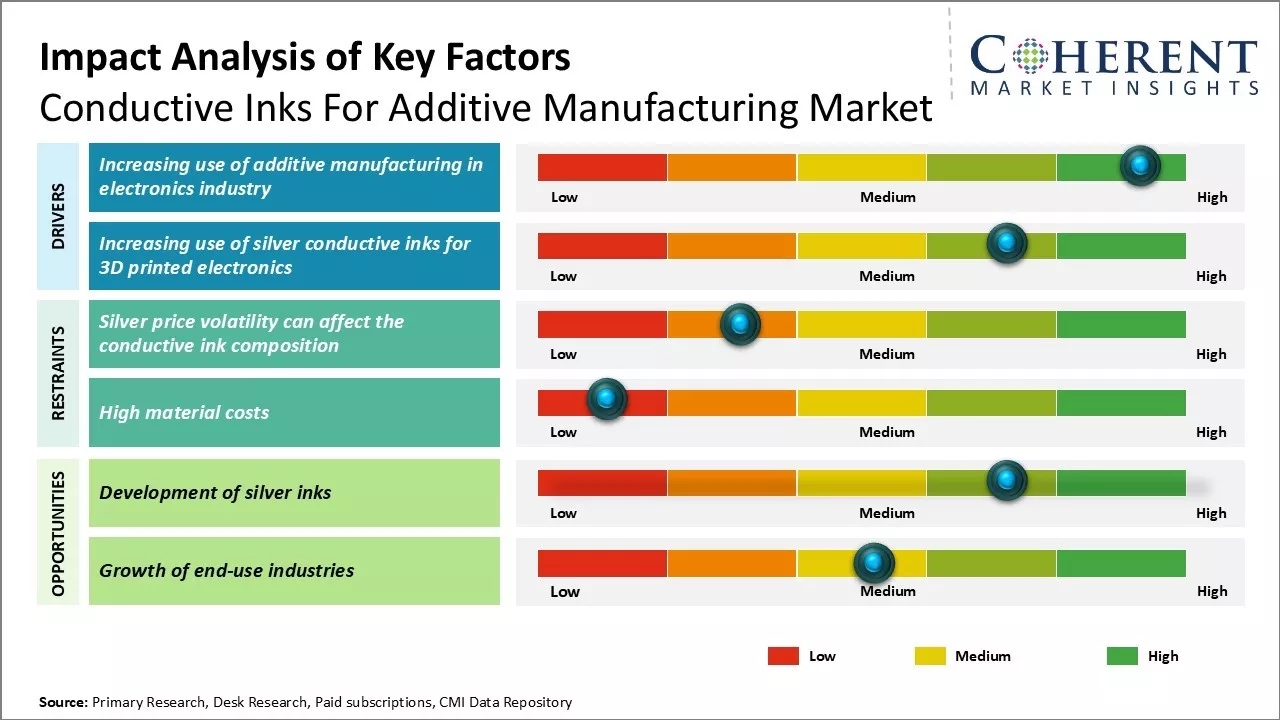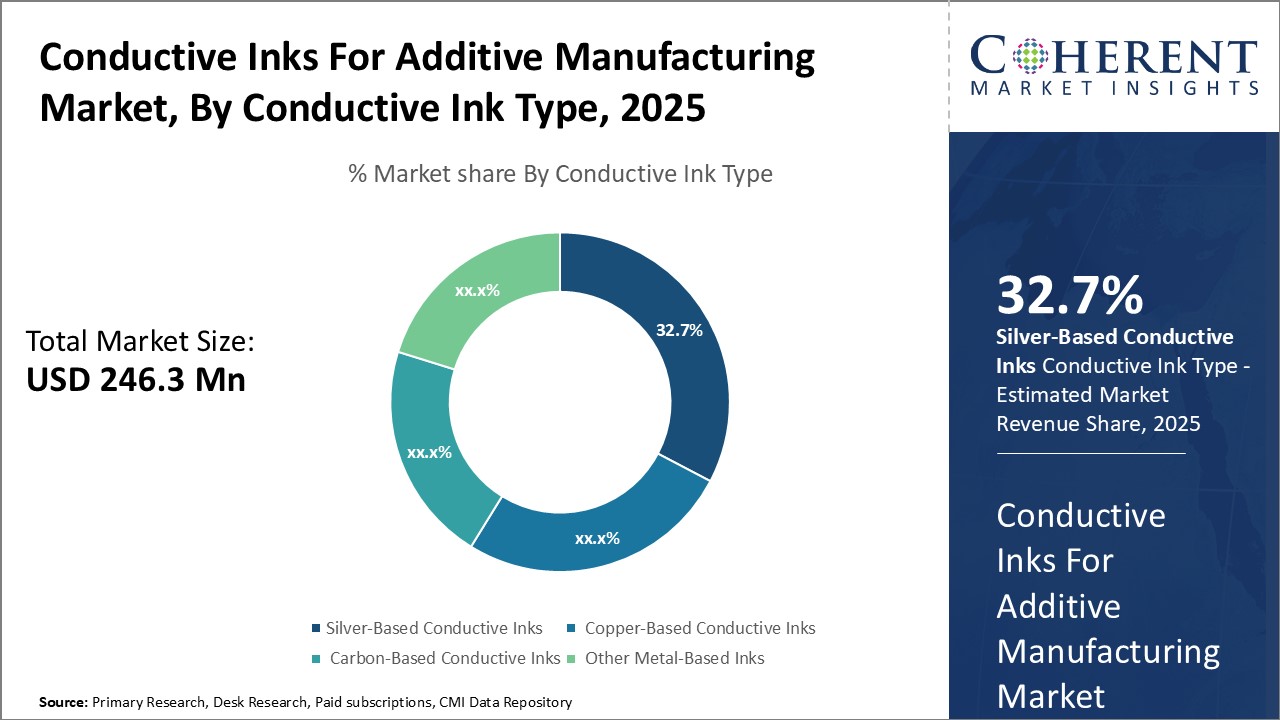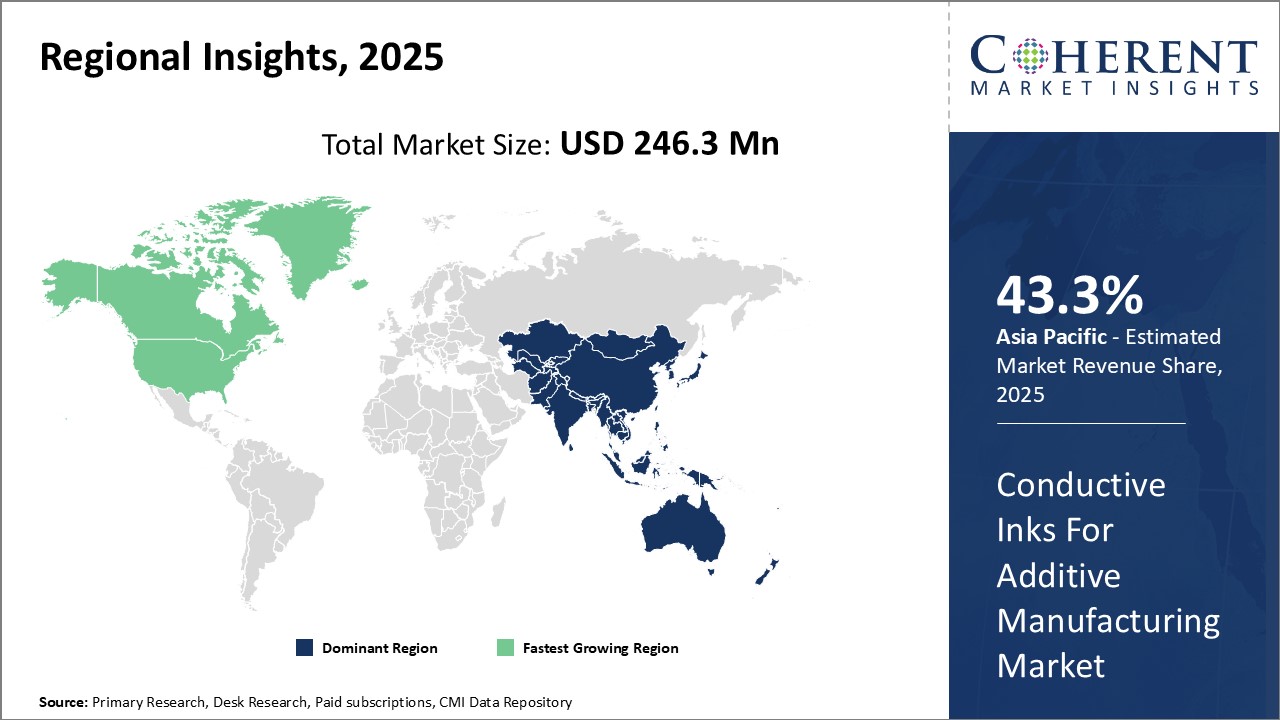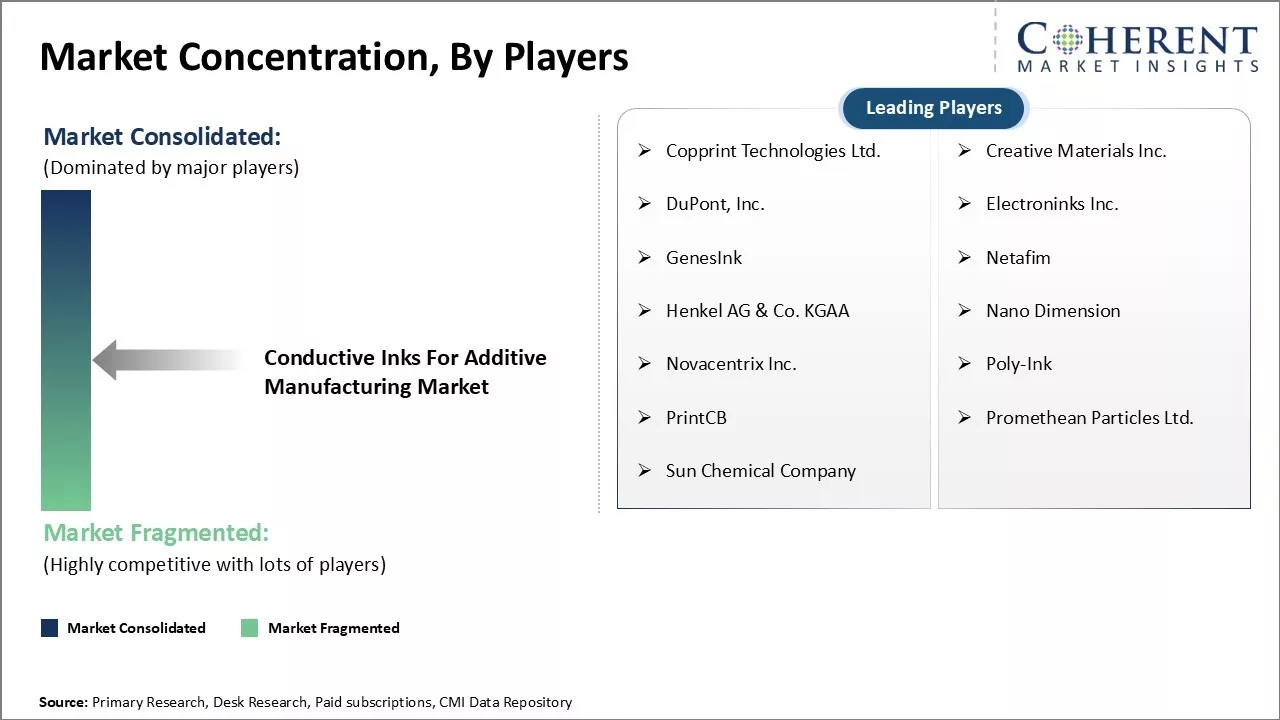
The conductive inks for additive manufacturing market are estimated to be valued at USD 246.3 Mn in 2025 and is expected to reach USD 946.7 Mn by 2032, exhibiting a compound annual growth rate (CAGR) of 21.2% from 2025 to 2032.

Discover market dynamics shaping the industry: Download Free Sample
The conductive inks for additive manufacturing market is expected to witness significant growth during the forecast period. This is primarily owing to the increasing applications of 3D printing across various industries such as automotive, consumer electronics, and healthcare. Furthermore, continuous advancements in 3D printing technologies along with reduction in prices of 3D printers will drive the demand for conductive inks for additive manufacturing which acts as a consumable or printing material in additive manufacturing process.

Discover high revenue pocket segments and roadmap to it: Download Free Sample
Insights, Conductive Ink Type - Rising Demand for Silver-Based Conductive Inks in Printed Electronics
In terms of the conductive ink type, the silver-based conductive inks segment is expected to contribute 32.7% share of the market in 2025, owing to their superior electrical and thermal conductivity properties. Silver-based inks have been widely used in printed electronics owing to silver's high electrical conductivity. Compared to other metals, silver provides high oxidation stability and solderability. The increasing usage of printed and flexible electronics has boosted the adoption of silver-based inks.
Insights, By Printing Technology - Dominating the Market for Conductive Inks in Printed Electronics Printing Technology
In terms of printing technology, the inkjet printing segment is expected to contribute 28.7% share of the market in 2025, owing to its ability to print a variety of conductive materials. Inkjet printing is commonly used for printed electronics applications owing to its non-contact, digital, and mask-less nature. It allows designers to rapidly alter print layouts without additional costs. Inkjet processing accommodates a wide range of ink types including silver, copper, and carbon in different solvents. Advanced inkjet heads have enabled finger printing resolutions down to 10 microns.
Insights, By End-use Industry - Surging demand for miniaturized gadgets
In terms of end-use Industry, electronics is expected to contribute 30.8% share of the market in 2025 owing to intensive usage of additive manufacturing in this industry. Rising demand for miniaturized portable electronics has pushed manufacturers to incorporate additive-conductive ink technologies. Components such as antennas, interconnects, sensors, and flexible circuits in smartphones, wearables, laptops, and other consumer gadgets rely on these techniques. Printed electronics allow gadgets to be made lighter, thinner, and more flexible. Miniaturized components enable continued device innovations.

Need a Different Region or Segment? Download Free Sample
Regional Analysis: Conductive Inks for Additive Manufacturing Market
Dominating Region: Asia Pacific
Asia Pacific is expected to account for the greatest revenue share, accounting for 43.3% in 2025. In Asia Pacific, the dominance in the conductive inks for additive manufacturing market can be attributed to strong government support for advanced manufacturing technologies. Countries like China and South Korea have implemented initiatives to drive innovation in additive manufacturing and Internet of Things (IoT). Leading electronics manufacturers with major presence in the region such as Samsung, LG, and others are actively investing in printed electronics applications. This has provided a boost to the usage of conductive inks for applications like wearables, smart packaging, and flexible displays.
Fastest-Growing Region: North America
The North America region exhibits the fastest growth, fueled by increased R&D investments by both public and private players. Government agencies like Defense Advanced Research Projects Agency (DARPA) and industry leaders such as Lockheed Martin are conducting research for applications in the defense and aerospace sectors. Several startups are also emerging in the region to offer customized conductive inks for additive manufacturing solutions for applications in consumer goods, medical devices and automotive.
Conductive Inks Market Outlook for Key Countries
U.S.: The U.S. market is driven by the presence of major conductive ink manufacturers such as DuPont and Henkel. Leading universities are working on developing advanced applications leveraging 3D printing technologies.
Canada: Canada market is supported by government grants for additive manufacturing research. Prominent players in the region include Applied Ink Solutions and NovaCentrix.
Mexico: Mexico continues to lead as a key manufacturing hub for electronics. Local players are increasingly adopting conductive inks for applications in the automotive and telecom industries.
Germany: Germany market is characterized by focus on novel production processes. Prominent German players drive innovation in the market including Vorbeck Materials and Creative Materials.

Get actionable strategies to beat competition: Download Free Sample
Top Strategies Followed by Conductive Inks for Additive Manufacturing Market Players
Established players in the conductive inks for additive manufacturing market focus heavily on research and development to produce innovative products. This allows them to stay at the forefront of technology and launch high-performance inks like those with enhanced conductivity, flexibility, or environmental stability.
Strategic partnerships are also crucial for major players to strengthen their market position. For example, DuPont has collaborations with key electronics manufacturers to develop customized ink solutions. This helps meet client needs while expanding sales opportunities.
Leading companies also grow their international presence. DuPont and Henkel have expanded distribution networks across Europe, North America, and Asia Pacific in recent years. This global expansion amplifies brand visibility and enables these players to tap into new regional customer bases.
Mid-level players differentiate through cost-effectiveness. Companies like Vorbeck Materials offer quality conductive inks at affordable price points. Collaborations also boost mid-tier companies. Vorbeck partners with application developers to optimize ink performance for specific 3D printing applications. This enhances technology adoption and allows Vorbeck to penetrate diverse end-use industries.
Emerging Startups in the Conductive Inks for Additive Manufacturing Market
When it comes to innovative technologies, startups like Nano Dimension are developing smart 3D printing materials. Nano Dimension's ‘DragonFly’ system prints electronics containing sensors and antennas using conductive nano-inks. This could transform IoT devices and wearables manufacturing.
Startups also focus on sustainability. Stepping Tools produces eco-friendly silver-based conductive inks from recycled electronic waste. Not only do these inks lower costs, but they address the growing e-waste problem and help organizations meet sustainability goals.
Some startups fill highly specific market gaps. InkSmith, for example, develops silver-based fluids for applications requiring extremely fine line widths like micro-electromechanical system (MEMs )and printed electronics. Addressing such niche needs allows startups to carve out profitable market spaces.
In January 2021, the Ministry of Electronics, IT & Technology of India announced a national strategy for additive manufacturing to promote the additive manufacturing industry in India.
Key Takeaways from Analyst
Conductive Inks for Additive Manufacturing Market Report Coverage
| Report Coverage | Details | ||
|---|---|---|---|
| Base Year: | 2024 | Market Size in 2025: | USD 246.3 Mn |
| Historical Data for: | 2020 To 2024 | Forecast Period: | 2025 To 2032 |
| Forecast Period 2025 to 2032 CAGR: | 21.2% | 2032 Value Projection: | USD 946.7 Mn |
| Geographies covered: |
|
||
| Segments covered: |
|
||
| Companies covered: |
Copprint Technologies Ltd., Creative Materials Inc., DuPont, Inc., Electroninks Inc., GenesInk, Netafim, Henkel AG & Co. KGAA, Nano Dimension, Novacentrix Inc., Poly-Ink, PrintCB, Promethean Particles Ltd., and Sun Chemical Company |
||
| Growth Drivers: |
|
||
| Restraints & Challenges: |
|
||
Uncover macros and micros vetted on 75+ parameters: Get instant access to report
Market Driver - Increasing use of additive manufacturing in electronics industry
The rise of additive manufacturing technology has revolutionized how electronics are designed and produced. 3D printing allows for unprecedented design flexibility that helps electronics firms develop complex components with intricate internal structures and innovative form factors that were not possible before.
For example, HP worked with Quad Industries to 3D print customized antennas for drones using its multipurpose conductive ink that delivered the required electrical and mechanical properties for the application. This has helped electronics innovators create miniaturized circuits, flexible electronics, wearable devices, and various Internet of Things (IoT) products that closely integrate electronics with mechanical structures. Quad Industries manufacturer flexible printed electronics, user interfaces, membrane switches, capacitive & haptic touch by quad industries for solution provider.
Market Challenge - Silver price volatility can affect the conductive ink composition
The price of silver is quite volatile and subject to fluctuation based on economic and geopolitical factors outside of the control of conductive ink manufacturers. As silver is a primary raw material for many conductive inks used in additive manufacturing applications, any increase in global silver prices can adversely impact margins and overall profitability for ink companies.
For example, according to the United States Geological Survey (USGS) data, the average monthly London Bullion Market Association price of silver fluctuated between US$ 21.67 per ounce in January 2022 and US$ 24.39 per ounce in March 2022. Ink makers must carefully consider silver pricing trends and hedge appropriately to minimize risks from supply chain disruptions and increase of input expenses over time.
Market Opportunity - Development of silver inks for new markets
The continuous expansion of the additive manufacturing industry into new applications and technologies presents strategic opportunities for conductive ink manufacturers to develop specialized silver-based products. Silver inks show strong potential for diverse sectors like printed electronics, 3D-printed sensors and Electromagnetic interference (EMI) shielding. By closely tracking emerging opportunities, ink companies can formulate new product lines targeting growth areas like IoT devices, biomedical implants, and functional consumer products. For example, data released in 2023, according to World Health Organization (WHO) estimates that by 2030, non-communicable diseases, chronic diseases will account for almost three quarters of all deaths worldwide. 3D printing offers opportunities to address medical device shortages and help better manage chronic diseases.
Share
Share
About Author
Yash Doshi is a Senior Management Consultant. He has 12+ years of experience in conducting research and handling consulting projects across verticals in APAC, EMEA, and the Americas.
He brings strong acumen in helping chemical companies navigate complex challenges and identify growth opportunities. He has deep expertise across the chemicals value chain, including commodity, specialty and fine chemicals, plastics and polymers, and petrochemicals. Yash is a sought-after speaker at industry conferences and contributes to various publications on topics related commodity, specialty and fine chemicals, plastics and polymers, and petrochemicals.
Missing comfort of reading report in your local language? Find your preferred language :
Transform your Strategy with Exclusive Trending Reports :
Frequently Asked Questions
Joining thousands of companies around the world committed to making the Excellent Business Solutions.
View All Our Clients